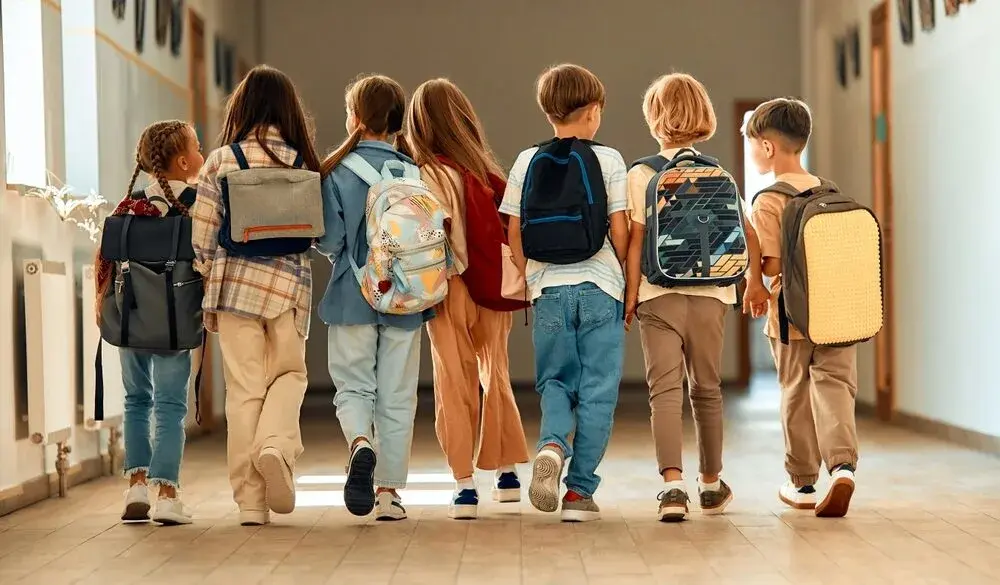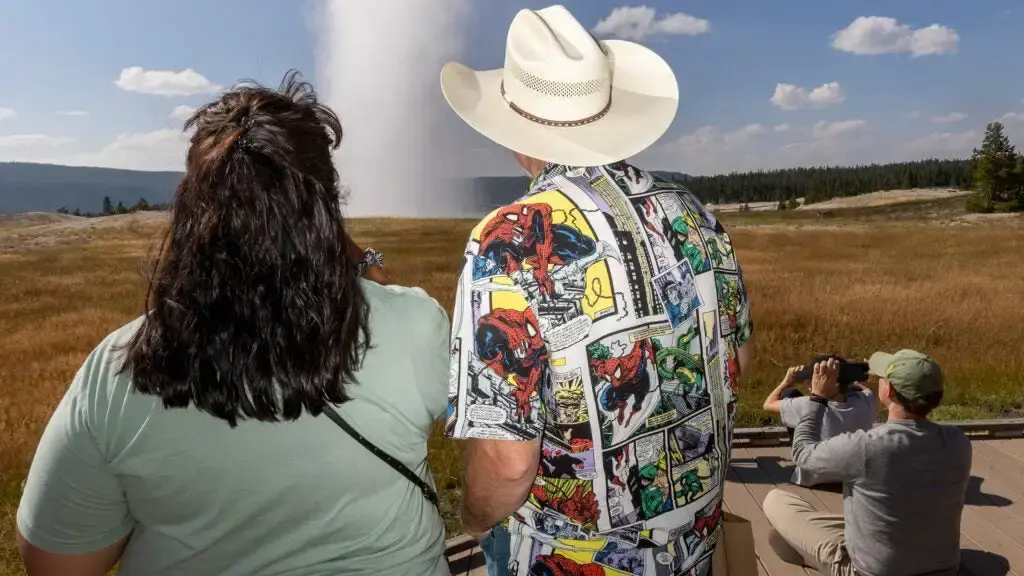
For Bisexual Awareness Week, Just Like Us ambassador Alice Pillin reflects on her journey with her bisexuality.

> I’m a proud bisexual and I adore our queer culture, so why do I still doubt that I’m allowed to take up this space? > > I remember the day I came out to my mum. Standing at the end of her bed one grey and drizzly evening, I used a sudden surge of confidence to tell her that I am bisexual. Initially, she didn’t understand. How could I like more than one gender if at that time I had a boyfriend? I did my best to answer her questions, and fortunately, she accepted me.
> But I was still grappling with self-doubt, compounded by casual, maybe even unconscious, bi-erasure from those around me. My friends would joke that the worst thing I could do was end up with a man – I’d be betraying myself, and my attraction to men surely couldn’t be real. > > I laughed too, as a bead of sweat rolled down my face. I was an imposter. I wasn’t queer enough. Quick! Someone play Chappell Roan and cleanse me of my sins! Should I overcompensate and date a woman immediately? The pressure to prove myself at times felt overwhelming. I didn’t feel good enough for my own community.
Nagorno-Karabakh is a mountainous enclave located in the South Caucasus. For decades, the territory has been the source of conflict between Armenia and Azerbaijan. It is internationally recognized as part of Azerbaijan, however, ethnic Armenians have been living in this territory for hundreds of yea...

Navajo and other historically oral languages pose special challenges for Arizona election officials trying to comply with federal law and capture sensitive issues.

Inside Out 2 is the highest-grossed animated film ever. But behind the scenes, Pixar workers grappled with crunch, layoffs, and an avoidance of LGBTQ+ themes. Our report of the tumultuous making of the sequel to one of the most beloved Pixar films ever.

An analysis of 15 ancient genomes from individuals dating to AD 1670–1950 from Rapa Nui (also known as Easter Island) addresses questions about the population history of the island.

> ## Abstract > Rapa Nui (also known as Easter Island) is one of the most isolated inhabited places in the world. It has captured the imagination of many owing to its archaeological record, which includes iconic megalithic statues called moai1. Two prominent contentions have arisen from the extensive study of Rapa Nui. First, the history of the Rapanui has been presented as a warning tale of resource overexploitation that would have culminated in a major population collapse—the ‘ecocide’ theory2,3,4. Second, the possibility of trans-Pacific voyages to the Americas pre-dating European contact is still debated5,6,7. Here, to address these questions, we reconstructed the genomic history of the Rapanui on the basis of 15 ancient Rapanui individuals that we radiocarbon dated (1670–1950 ce) and whole-genome sequenced (0.4–25.6×). We find that these individuals are Polynesian in origin and most closely related to present-day Rapanui, a finding that will contribute to repatriation efforts. Through effective population size reconstructions and extensive population genetics simulations, we reject a scenario involving a severe population bottleneck during the 1600s, as proposed by the ecocide theory. Furthermore, the ancient and present-day Rapanui carry similar proportions of Native American admixture (about 10%). Using a Bayesian approach integrating genetic and radiocarbon dates, we estimate that this admixture event occurred about 1250–1430 ce.
> Ballot initiatives are the tool we need in this moment to not only block authoritarian rule and ideology, but to build a world where all of us thrive and live with dignity — the world we deserve.
> Time and time again, ballot measures have proven to be powerful tools for collaborative governance that transcend party lines and often receive higher vote percentages than candidates. This trend started in 2014 when four states, Alaska, Arkansas, Nebraska, and South Dakota, raised the minimum wage through ballot measures; another four states, Arizona, Colorado, Maine, and Washington, followed suit in 2016. Florida made headlines across the country in 2018 when nearly 65% of Florida voters approved Amendment 4 to restore voting rights to Floridians with past criminal convictions. > > In 2020, Missouri and Oklahoma expanded Medicaid to low-income adults, which has proven to significantly benefit individuals who gain healthcare coverage as well as their communities as a whole. Since the overturning of Roe, voters have successfully protected reproductive rights every time the issue has been placed on the ballot. In Ohio—a state that Trump won with more than 53% of the vote in 2020—hundreds of thousands of voters mobilized in the 2023 elections to pass Issue 1, enshrining the right to abortion in the state constitution just months after they successfully defeated a ballot measure that would have blocked that victory. These are just a few instances that showcase how voters have used the power of direct democracy to support progressive policies, even in Republican trifecta states. Ballot measures are bypassing partisan politics and turning people-power into policies that transcend divides and improve lives.
Lukas Müller, the Würenlos school director, attributes the success of the ban to several factors. For one, the school board agreed way back in 2007 to keep phones out of classrooms. “But it led to students using them incessantly in the breaks or taking bathroom breaks to look at their phones,” remembers Müller, who has been at the school since 2004. “That was just at the start of the iPhone boom.” Studies show that requests to turn off their phones while students are allowed to keep the devices with them during class are rarely successful, and up to 97 percent of students can’t resist the temptation to check their emails or apps. So the board decided the following year to ban phone use in the entire school area. “The students are indeed less distracted,” Müller has observed. And because his K-12 school starts at kindergarten and teaches students all the way through senior year, students get used to being phoneless in school long before they become attached to Instagram or TikTok.
But the solution isn’t as simple as banning all digital devices. The problem isn’t the use of these devices per se, but excessive use and the kind of content students access. Students who spend one to five hours per day on digital devices for learning at school score significantly higher in their mathematics lessons than those who spend no time on such devices, the OECD concludes: “In contrast, students spending over one hour on digital devices for leisure at school score more than nine points lower in mathematics and report a lower sense of belonging at school than students who spend no time on leisure digital activities.”
It isn't as simple as prohibiting all devices — but going phone-free can help kids thrive, especially when they’re offered fun alternatives to screen time.

Thurman waited in pain in a hospital bed, worried about what would happen to her 6-year-old son, as doctors monitored her infection spreading, her blood pressure sinking and her organs beginning to fail.
It took 20 hours for doctors to finally operate. By then, it was too late.
The otherwise healthy 28-year-old medical assistant, who had her sights set on nursing school, should not have died, an official state committee recently concluded.
Though Republican lawmakers who voted for state bans on abortion say the laws have exceptions to protect the “life of the mother,” medical experts cautioned that the language is not rooted in science and ignores the fast-moving realities of medicine.
The most restrictive state laws, experts predicted, would pit doctors’ fears of prosecution against their patients’ health needs, requiring providers to make sure their patient was inarguably on the brink of death or facing “irreversible” harm when they intervened with procedures like a D&C.
“They would feel the need to wait for a higher blood pressure, wait for a higher fever — really got to justify this one — bleed a little bit more,” Dr. Melissa Kottke, an OB-GYN at Emory, warned lawmakers in 2019 during one of the hearings over Georgia’s ban.
At least two women in Georgia died after they couldn’t access legal abortions and timely medical care in their state, ProPublica has found. This is one of their stories.

> Rather than fearing polarization, organizers should seek to understand how they can use it most effectively. This involves recognizing that, while collective action undertaken in pursuit of a good cause typically results in positive outcomes, not all protests have identical effects or produce equal benefits. > > Central to harnessing the power of polarization is appreciating that, by its nature, it cuts both ways: the same actions that create positive polarization — drawing more active supporters into movements and convincing previously neutral or undecided observers to at least passively sympathize with the cause — will also have negative effects, turning off some people and firing up the opposition. The goal of movement participants is therefore to make sure that the beneficial results of their actions outweigh the counterproductive ones, and that they are shifting the overall spectrum of support in their favor.
> So how, then, can movement participants predict how a given protest will polarize? And how can they work to improve their skills in designing effective actions?
Despite the popularity of unions being at a record high, workers in the food service industry face an uphill battle when it comes to fighting for collective bargaining rights. Hospitality unions and workers are trying to change that.

i'm back after an absence; i've been working on a bunch of stuff because Cohost is shutting down at the end of the month.
the result: i have a website now, and i'm porting over my essays and running my union blog out of that. i have an RSS feed that works for both, as far as i can tell. things seem like they're calming down now so hopefully i'll be able to be around more for the remainder of this month
three paragraphs saying you're wrong and that the empirical evidence supports nothing you're saying is not a "long-winded rant" lmao--this uncritical "trust me bro it's actually fine, you just don't get it" stuff is the exact reason i consider autonomous vehicle stuff to 98% worthless techbro hype and autofellatio. cite your sources if you want people to listen--i have, and you've refuted none of it!
The whole point of induced demand in highways is that when you add capacity in the form of lanes it induces demand. So if our highways are already full and if that capacity isn’t coming from increased EV efficiency then where is it coming from? If there’s no increase in road capacity then what is inducing demand?
just for example: "freeing up both parking lot real estate, but more importantly, freeing up on street parking, creating more room for actual traffic to move"--every single one of these posited improvements would induce demand unless you literally demolish the infrastructure (which, if you're just switching people one-to-one from regular cars to automated cars is not going to happen, because the number of cars will remain a constant). the existence of unused parking begets driving and is a predictor for more driving.[^1] the existence of more space to move obviously begets more driving because the "highways" aren't "full" anymore; and again, if it didn't that would actually be worse because it incentivizes less safe driving practices.
You are describing how humans drive, not AVs. AVs always obey the speed limit and traffic calming signs.
if by AVs you mean "fully autonomous" ones that literally do not exist currently then sure--they better! but at that point nothing you say is meaningful, because the technology literally doesn't exist. we might as well be talking about mass-adopted hydrogen cars or whatever.
but, if we mean semi-autonomous ones—the ones that clearly exist, and which companies advertise as autonomous, and which people actually use—no. absolutely not. these things routinely violate even the most obvious traffic laws and necessitate humans to intervene in their ordinary function. Waymo hits pedestrians even now, and it's ostensibly one of the most advanced semi-autonomous programs in the world. Uber literally killed a pedestrian and got into legal trouble over it. Tesla's problems are omnipresent to the point where the NHTSA has said their feature is unsafe in practice and people make it a punchline. you can't no-true-Scotsman this technology. even in the best and least ambiguous traffic circumstances it has obvious problems!
[^1]: > In 2015, a group of researchers led by Chris McCahill looked at historical trends in parking supply and commuter behavior for nine cities: Albany, New York; Berkeley, California; the Washington, DC, suburbs of Arlington, Virginia, and Silver Spring, Maryland; Cambridge, Lowell, and Somerville, Massachusetts; and Hartford and New Haven, Connecticut. Using historical aerial photography from three dates to identify and approximate the parking supply, McCahill found that parking growth between 1960 and 1980 was a “powerful predictor” of car use in the following two decades. Every ten spaces added per one hundred residents before 1980 were linked to an 8 percent increase in the share of residents driving to work after 1980. Increase in the parking supply in the study’s first two decades was directly correlated with increases in car use in the following two decades. More parking appeared to cause more driving, not the other way around.
Yes, I have no doubt there would be induced demand, but that extra demand wouldn’t be at the cost of anything.
But if AVs add more capacity to our roads, that will be entirely because they are driving more efficiently.
you are literally doing what i mean when i say you are making assumptions with no evidence. there is, again, no reason to believe that "driving more efficiently" will result from mass-adoption of automated vehicles--and even granting they do, your assumption that this wouldn't be gobbled up by induced demand is intuitively disprovable. even the argumentation here parallels other cases where induced demand happens! "build[ing] new roads or widen[ing] existing ones" is a measure that is almost always justified by an underlying belief that we need to improve efficiency and productivity in existing traffic flows,[^1] and obviously traffic flow does not improve in such cases.
but granting that you're correct on all of that somehow: more efficiency (and less congestion) would be worse than inducing demand. "efficiency" in the case of traffic means more traffic flow at faster speeds, which is less safe for everyone—not more.[^2] in general: people drive faster, more recklessly, and less attentively when you give them more space to work with (especially on open roadways with no calming measures like freeways, which are the sorts of roads autonomous vehicles seem to do best on). there is no reason to believe they would do this better in an autonomous vehicle, which if anything incentivizes many of those behaviors by giving people a false sense of security (in part because of advertising and overhyping to that end!).
You’re asking for something that does not exist. How am I supposed to provide you evidence proving what the results of mass adoption of AVs will be when there has never been a mass adoption of AVs.
you asserted these as "other secondary effects to AVs"--i'm not sure why you would do that and then be surprised when people challenge your assertion. but i'm glad we agree: these don't exist, and they're not benefits of mass adoption nor would they likely occur in a mass adoption scenario.
For instance, what is your reasoning for believing that AVs could never be fundamentally safer than human drivers who are frequently tired, angry, distracted, impaired, impatient, etc?
the vast majority of road safety is a product of engineering and not a product of human driving ability, what car you drive or its capabilities, or other variables of that nature. almost all of the problems with, for example, American roadways are design problems that incentivize unsafe behaviors in the first place (and as a result inform everything from the ubiquity of speeding to downstream consumer preferences in cars). to put it bluntly: you cannot and will not fix road safety through automated vehicles, doubly so with your specific touted advantages in this conversation. the road designs that create bad driving behavior don't cease to be an issue because people switch to an automated vehicle.
[^1]: take for instance “Tackling Traffic Congestion,” Transportation Quarterly 40, no. 2 (1986), which states "growing congestion [in the Bay Area] [...] is the result of development that comes with an improving economy compounded by a lagging expansion of freeway and transit capacity." [^2]: see for instance Leonard Evans, “Future Predictions and Traffic Safety Research,” Transportation Quarterly 47, no. 1 (1993): “although congestion impedes mobility, it increases safety, as measured by serious injuries and fatalities.” and Arnold Vey, “Relationship between Daily Traffic and Accident Rates,” American City 52, no. 9 (1937), who observed that beyond a certain point congestion reduced accident rates. congestion unsurprisingly acts as a calming measure when it becomes severe enough.
As long as cars exist, AVs will be better than human drivers,
this is at obvious odds with the current state of self-driving technology itself--which is (as i noted in the other comment) subject to routine overhyping and also has rather minimal oversight and regulation generally. Tesla is only the most egregious example in both respects; even stuff like Waymo is pretty much entirely reliant on taking their word for it that the technology would be safer than humans (which meshes awkwardly with well publicized problems and efforts to hide robotaxi safety records).
Secondly, it’s based on the idea that people even can drive more than they already do.
they can. induced demand is omnipresent in basically all vehicular infrastructure and vehicular improvements and there's no reason to think this would differ with autonomous vehicles
Fourthly, it ignores other secondary effects to AVs, like suddenly not needing nearly as much parking, freeing up both parking lot real estate, but more importantly, freeing up on street parking, creating more room for actual traffic to move, and their increased patience not causing constant traffic jams because they tailgated someone and then slammed on the brakes.
okay but: literally none of this follows from mass-adoption of autonomous vehicles. this is a logical leap you are making with no supporting evidence—there is, and i cannot stress this enough, no evidence that if mass-adoption occurs any of this will follow—and in general the technology is subject to far more fabulism and exaggeration (like this!) than legitimate technological advancement or improvement of society.
When you make something easy to use, people want to do it more.

> Enticing though they are, such arguments conceal a logical flaw. As a classic 19th-century theory known as a Jevons paradox explains, even if autonomous vehicles eventually work perfectly — an enormous “if” — they are likely to increase total emissions and crash deaths, simply because people will use them so much.
by Sabine Harrer and Outi Laiti Published September, 2023. Download full pdf of article here. Abstract While in recent years many European businesses have taken steps to alter their previously raci…

> While in recent years many European businesses have taken steps to alter their previously racist product designs, some games, especially board games like the popular Finnish Afrikan tähti (Star of Africa; Kuvataide, 1951), resist this trend. This raises two questions: First, what are the emotional mechanics which allow openly racist games like Afrikan tähti to remain unchanged and celebrated as ‘classics’ today? Secondly, what can our predominantly white board and role-playing game communities do to let go of emotional attachments to white supremacist games and become invested in a more respectful and welcoming games culture?
> [...]we speculate on ways to expedite collective grief to help players reach what we term the ‘white acceptance stage’. We speculate that one useful design intervention to help rethink Afrikan tähti might be to classify it as a PEGI 18 game with the descriptor ‘discrimination’. Seen in this new light, the game might find a new purpose as a cultural educational item complementing lessons on Europe’s colonial past and the self-image of (Northern) Europe for older children. This intervention is inspired by the recent introduction of sensitivity warnings by multinational entertainment corporations such as Disney and broadcasting agencies like YLE (Rytsä, 2007). We argue that adopting such labeling practices for popular board games like Afrikan tähti can be a first step towards confronting racist and colonial ludic heritage.
Two residents of Lee County said they were questioned at their homes about the validity of petition signatures.

The “dynamic pricing” model, which ramps up costs in line with demand, could be banned or restricted

Petting bison, cooking food in geysers. Ride along with our writer on a wild trip to our nation's most iconic national park at the height of tourist season to see all the bad behavior.

> The U.S. has a near-infinite supply of clueless tourists such as myself, much to the dismay of our National Park Service. Yellowstone, our most famous national park thanks to Kevin Costner, welcomes 4.5 million of us each year. Like all of our parks, Yellowstone takes in tourists not only for the revenue but to remind them that the physical country they reside in is a marvel well beyond their comprehension. As such, Yellowstone is set up to accommodate these hordes. And while park officials do their best to keep tourists in line, often literally, my kind still manage to do plenty of tourist shit. We trample plant life. We get shitfaced and pick unwinnable fights with animals ten times our size. And we hurt ourselves. According to NPS data, at least 74 people have died while visiting Yellowstone in the past 15 years. I could have been one of those people. I deserve to be one of those people. > > This is why Outside sent me to the park just a few weeks ago, during one of the busiest times of the year. They wanted me to observe our most basic tourists in the wild. Maybe I’d even get to see one die. Or, even better for my editors, maybe I would die while I was there. Maybe I’d look down my nose at the tourists around me only to end up as wolf food myself. Like most other Yellowstone visitors, I was not trained for the outdoors, I relish doing shit that posted signs yell at me not to do, and I often daydream about fighting bears (and winning!). I find danger tempting, which isn’t a good thing given that I can no longer swim a single pool lap without taking a break. Are people like me responsible enough to visit one of our national treasures without breaking it? Do we, as a population, know how to do national parks?
America’s collective decision in the 20th century to make cars and the roads serving them the bedrock of all urban and regional planning will go down in history as just another of our nation’s awful, ruinous ideas that we nevertheless clung to for generations, like slavery or lead paint. Cars, of course, have a way of making themselves very hard to progress away from. Once you build the towns and cities around the road patterns for cars, and allow the interstate highway system to determine development patterns, the entire system gets locked in in a way that is difficult to change. Even as ever-widening highways and air pollution and the immense parking lots destroy ever larger swaths of peace and scenery, they also represent ever larger sunk costs from consumers and governments, which make everyone more reluctant to try to break away from them.
New cars spawn new roads. New roads spawn new sprawl. It all spawns new debts. To admit that this entire thing was a mistake involves surveying our suburban homes, our paved driveways, our SUVs, our shopping centers, our entire beloved home towns, and saying: Okay, this has all gotten out of control. As all addicts know, this piercing self-criticism can be more difficult than just continuing doing something that is unhealthy, but familiar.
The car-centric age of development is one long mistake.

Anti-smoking legislation is evidence of an authoritarian society. Lifestyle control and coercive paternalism appease the whims of fanatics who hold positions of influence. In a free economy, demand dictates supply. Smoking bans and restrictions are only in place because there is currently not enough demand for smoke-free establishments to appease those who claim they speak for all society. The will of a few is being forced on the many.
wanting to exist in a society where you don't get second-hand lung cancer is not fascism, oh my god. it is perfectly socially acceptable and not even the slightest bit "authoritarian" to regulate actions that can directly harm other people. and this is an absolutely comical free-market-absolutist-brained idea of what freedom is.
There were 77 times more signups than available vouchers.

> Emily Gedeon, a spokesperson for Denver's climate office, said there's no foul play at work here — just enormous demand. About 17,000 people tried to get a voucher on Tuesday, she told us, more than 77 times the amount available [220 vouchers]
for people who have passed a morality test
i don't see how this is even theoretically tenable considering what is "moral" is entirely subjective and largely nonfalsifiable
That said, some have a religious prerogative to not vote, and should be eligible for an exemption.
this is, as i understand, the case in Australia—which i would consider the most compelling example of compulsory voting in practice.
still the case (but the same fediverse); we move at the pace of development and unfortunately that has slowed a bit in the case of Sublinks
you're being way too vitriolic here, dial it back by 10.
It’s not racist when they call him white boy, it’s racist he tells that story.
if you think calling people "white boy" is racist but the way he talks about indigenous people here isn't you are such a fragile little cracker it's not even funny
i forget the exact reason but i believe it has something to do with OCEF being in Europe, which means taxes, exchange rates, and other annoying variables like that come into play for us which weren't previously contributors on OCF
This is presented in a confusing way to me. But I see after reading it twice that monthly recurring contributions are $80.82 per month (I’m assuming this is after fees that OCEF charges).
yes--this is why all the contribution numbers are weird and non-round. i believe we also lose out something like 5-6% to fees vs. the previous 3-4% fees we had on Open Collective Foundation—smaller donations definitely get punished a bit more heavily now.
When South Korea started tackling this problem 20 years ago, it threw away 98 percent of its food waste. Today, 98 percent of food waste is turned into feed, compost or energy, according to the South Korean Ministry of Environment. It achieved this by banning food scraps from landfills and mandating that all residents separate their food waste from their trash and recycling — and to pay for the service through fees and fines.
South Korea is one of the few countries with a nationwide system for food-waste management. While France made composting food mandatory this year — and some cities like New York have imposed similar rules — few places match up with South Korea.
it's just unbelievable how dangerous it is to bike anywhere in America because of how reckless drivers tend to be. (and in this case it's particularly devastating because both were in town for their sister's wedding)
Since June 10, the campaign has organized multiple disruptive civil disobedience actions every single week. Convened by Climate Defenders, Planet Over Profit, Stop the Money Pipeline and New York Communities for Change (where I am the senior climate campaigner), and endorsed by over 115 partner groups, the protests have been attended by over 4,000 people, and more than 600 have been arrested. Actions have included sit-ins at the biggest banks and insurance companies backing fossil fuel projects, interruptions of Wall Street executives’ public appearances and visits to those executives’ homes. But most of all, they have consisted of numerous blockades of the entrances to the global headquarters of Citi, preventing employees from entering work multiple times a week.
Colorado officials are now proposing to go further. In 2023, the state adopted legislation to try something that’s never been done in this country: automatically register tribal members to vote in U.S. elections.
The program, if implemented, would enable tribes to share their membership lists with Colorado elections officials, who’d then use that information to register every eligible person to vote, while giving them a chance to opt out. Since Colorado already mails ballots to every registered voter, this would necessarily mean getting ballots into the hands of more Native people. “We’ve made real steps forward, and we’re going to continue,” Colorado Secretary of State Jena Griswold told me recently. “We always try to push the envelope.”
And yet, Cloud is also keenly concerned that the program could make her community more vulnerable. For U.S. election officials to automatically register tribal members to vote, the tribes would need to share certain vital information about their members, such as full name, address, and date of birth. Cloud is hesitant to hand this data over to a state that has, over a long history that she knows too well, been an agent of violence.